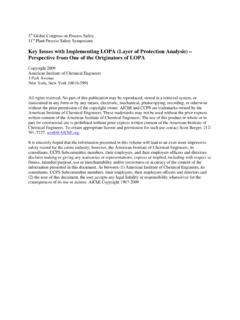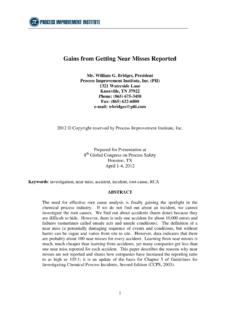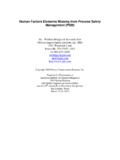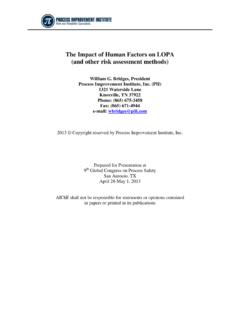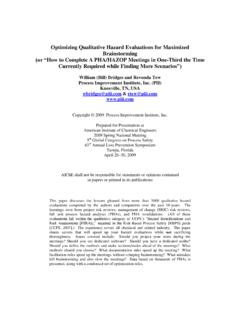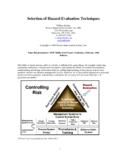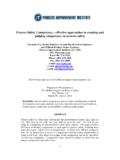Transcription of More Issues with LOPA - from the Originators
1 Global Congress on Process Safety - 2015. _____. more Issues with LOPA - from the Originators A. M. (Art) Dowell, III, PE. Process Improvement Institute, Inc. (PII). 2437 Bay Area Blvd PMB 260. Houston TX 77058-1519. phone: 713-865-6135. e-mail: William G. Bridges, President Process Improvement Institute, Inc. (PII). 1321 Waterside Lane Knoxville, TN 37922. Phone: (865) 675-3458. Fax: (865) 622-6800. e-mail: 2015 Copyright reserved by Process Improvement Institute, Inc. Prepared for Presentation at 11th Global Congress on Process Safety Austin, TX. April 27, 2015. UNPUBLISHED. AIChE shall not be responsible for statements or opinions contained in papers or printed in its publications Global Congress on Process Safety - 2015. _____. more Issues with LOPA - from the Originators A. M. (Art) Dowell, III, PE. Process Improvement Institute, Inc. (PII). William G. Bridges, President Process Improvement Institute, Inc. (PII). Keywords: process safety culture, process safety management, near miss reporting, human factors, leadership, accountability, China Abstract Layer of protection analysis (LOPA) has now been around for more 20 years (and in general use for 15 years), with the initial textbook being officially published in 2001.
2 Most recently, two companion books have been published on the topics of Enabling Events & Conditional Modifiers and on Initiating Events and Independent Protection Layers (IPLs). Many papers have been published in the past 20 years on LOPA. This paper shares observations and lessons learned from two Originators of LOPA and provides further guidance on how to and how Not to use LOPA. The paper provides specific examples of best practices, some of which are not covered well enough in or are omitted from the textbooks on the topic. Global Congress on Process Safety - 2015. _____. Brief History of LOPA. The initial development of layer of protection analysis (LOPA) was done internally within several individual companies. However, once a method had been developed and refined, several companies published papers describing the driving forces behind their efforts to develop the method, their experience with LOPA, and examples of its use (Bridges, 19971; Dowell, 19972.)
3 Ewbank and York, 19973). In particular, the papers and discussion among the attendees at the October 1997 CCPS (Center for Chemical Process Safety, part of AIChE), International Conference and Workshop on Risk Analysis in Process Safety, brought agreement that a book describing the LOPA method should be developed. In parallel with these efforts, discussions took place on the requirements for the design of safety instrumented systems (SIS) to provide the required levels of availability. United States and international standards (ISA [1996], IEC [1998, 2000])4,5,6 described the architecture and design features of SISs. Informative sections suggested methods to determine the required safety integrity level (SIL), but LOPA was not mentioned until the draft of International Electrotechnical Commission (IEC) 61511, Part 3, which appeared in late 1999. These Issues were summarized in the CCPS workshop on the application of ISA S84, held in 2000.
4 The first LOPA book was developed by a CCPS committee from 1997 through 2000 and was published in 20017 (Art Dowell and William Bridges were the co- Originators and were principal authors of the book). LOPA has become widely used following the publication of the LOPA. textbook nearly 15 years ago. Especially during the last 10-years, use of LOPA has greatly accelerated. It is likely that several million LOPAs have been performed. During this same period, many abuses of LOPA have been noted (many of these are now even engrained across the chemical industry), and several innovations have occurred. In 2007, CCPS commissioned a new guideline book (1) to expand the list of independent protection layers (IPLs) and initiating events (IEs) and (2) to try to remedy some of the major Issues noted in the use of LOPA. The new book has been discussed in other papers at past conferences; this book is Guidelines for Initiating Events and Independent Protection Layers, CCPS/AIChE, 20158.
5 William Bridges was the primary contractor/author of this book from 2007 to April 2012. Another companion book on related topics, Guidelines for Conditional Modifiers and Enabling Events9, CCPS/AIChE was published in 2013; Mr. Bridges was a committee member and contributed to this book as well. This paper comments on deficiencies and dangerous precedents in both of these newer textbooks. Intent of LOPA. LOPA is one of many methods for assessing a given scenario to determine if the risk is tolerable. It uses rigid rules to simplify and standardize the definitions of independent protection layers (IPLs) and initiating events (IEs). If these rules are followed, then the simplified risk assessment math of LOPA is valid and the risk assessment should give an order-of-magnitude approximation of the risk of a given cause-consequence pair (scenario). The rules also cover the minimum criteria for maintaining features and task executions that relate to IEs and IPLs.
6 Global Congress on Process Safety - 2015. _____. LOPA is only one option for judging risk. A common method for judging the risk of most scenarios is the process hazard analysis (PHA) team; their judgment is qualitative, but the fuzzy math of the individual team members frequently coalesces into excellent judgment of risk for most accident scenarios. On the other hand, the judgment of the PHA team is slanted by the experience of the team members, and it frequently can be helpful to use LOPA to provide consistency in risk decisions. A key responsibility of the PHA team (or LOPA analyst) is to assess the consequence severity correctly. Given an accurate understanding of the consequence severity, LOPA can quickly evaluate the likely frequency of the initiating event and the effectiveness of the IPLs. Relationship to SIL determination LOPA started with and continues to have a unique relationship with SIS, and particularly to SIF. identification and SIL assignment (sometimes called SIL determination).
7 Some of the Originators of LOPA needed LOPA to defend against an arbitrary assignment of safety instrumented functions (SIFs) for systems that were already adequately safeguarded by other means. This became apparent in the mid-1990s with the early development of SIS standards within chemical companies and by (at that time) the Instrument Society of America (ISA). Some of these early standards would have imposed a minimum SIL for a given consequence, without much regard for the number and value of other IPLs that already existed or were viable alternatives to the SIFs. Much of these arbitrary requirements for SIS have disappeared, but some remain. For the most part today, LOPA is seen as one tool (in many parts of the world, the preferred tool). for determining if a SIF is necessary and if it is the correct choice for risk reduction; and LOPA. is the preferred method for determining what SIL is necessary, if an SIF is chosen as the risk reduction method.
8 Summary of Issues with the Current Implementation of LOPA. While LOPA has been a great benefit to industry, we have observed many Issues with the implementation of LOPA over the 15+ years of use. 1. One of the biggest problems with LOPA is that its users do not always follow the rules of LOPA. A major problem is that IPL and IE values are picked from a list, while the specific IEs and IPLs are (1) not validated to have the stated value and (2) not maintained to sustain the stated value. Below is a listing of the rules for IPLs ( with impact on IEs as well), and descriptions of the problems we have observed: The frequency (likelihood) for an IE or the probability of failure on demand (PFD). for an IPL applies to the entire boundary of that IE or IPL. The IE or IPL includes any items on or off of the P&IDs and other reference documents that could increase the unreliability or unavailability of the IE or IPL. So, root valves, isolation valves, and hardware or software bypasses are all part of the definition of an IPL or IE.
9 This concern is especially important for high integrity protection systems such as PSVs pressure Global Congress on Process Safety - 2015. _____. safety valves (where PFDs can be for a single PSV to for dual, full-size PSVs). and for SIL 2 and SIL 3 instrumented functions. If the IPL is a PSV, then the IPL system must include upstream and downstream features, such as isolation valves (Figure 1). Therefore, the probability of leaving an isolation valve closed should be included as a contribution to the overall PFD of the PSV. IPL system. Figure 1: Boundary for PSV (courtesy of Process Improvement Institute, Inc.). In this case, actual data from industrial plants of all types have shown that the probability of leaving a block valve closed (upstream or downstream of the PSV) is a significant portion of and sometimes dominating factor in the PFD of the PSV. In several studies by different companies shared during the writing of Guidelines for Initiating Events and Independent Protection Layers8, the sites found that the PFD of the PSV was in the range of to , whereas the probability of the upstream or downstream block valve being in the inadvertently-left-closed position (but with a CSO [car sealed open] tag in place!)
10 !) was about to This finding led that book writing committee to state that the PFD of a PSV with upstream or downstream block valves (using a standard CSO. system for administrative control of the block valves) must be set at , until the site: proves by independent auditing that the error rate of leaving a block valve closed in less than installs more reliable means to ensure the flow path is open, such as: Global Congress on Process Safety - 2015. _____. o using dual relief valves with a three-way Y-valve to switch flow paths (The three way valve shall be configured to provide the full-flow path at all times during the switching operation.). o installing a captive key system of the proper sequence to ensure the block valves in one flow path are open before starting up ( , before opening a potential pressure source to the protected equipment). o installing limit switches to verify the valves are open and interlocking the position switches to a permissive that must be cleared before startup A similar situation relates to high integrity SIFs (SIL 2 and SIL 3).
